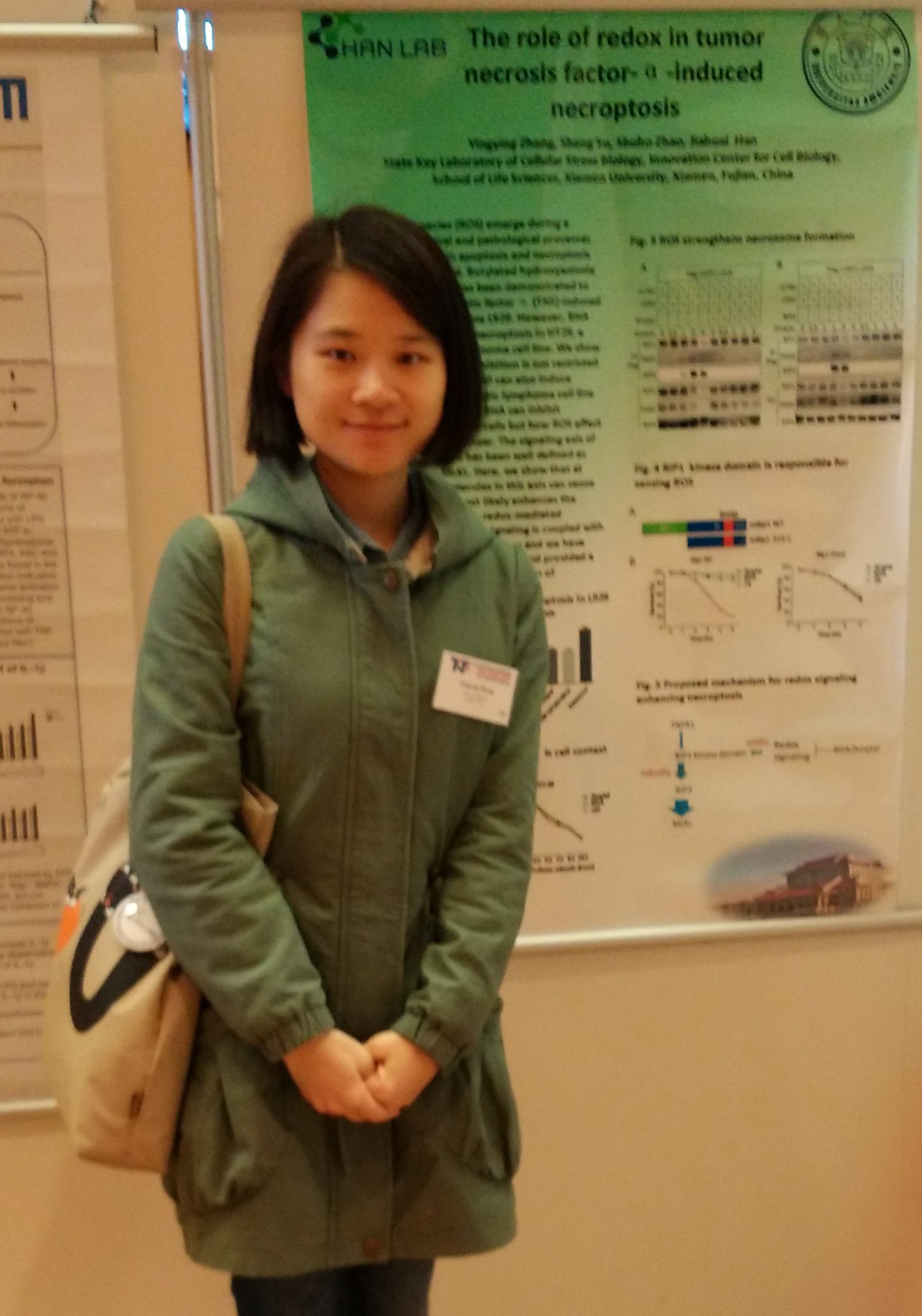Yingying ZHANG,Ph.D.
Assistant Professor
E-mail: y.zhang@xmu.edu.cn
2006-2010,School of Life Sciences, Xiamen University, B.S.
2010-2016,School of Life Sciences, Xiamen University, Ph.D.
2017-present, School of Life Sciences, Xiamen University, Assistant Professor
Research Area
Dr. Yingying Zhang has been trained in Prof. Jiahuai Han’s lab for more than eight years and now she works as assistant professor in Han Lab. Dr. Jiahuai Han is known for the discovery of the p38 signaling pathway, one of the most important pathways in intracellular signaling transduction. This pathway plays important roles in many biological processes including cell cycle regulation, cell proliferation, cell differentiation and senescence, as well as immunity, development and tumorigenesis. Another current focus of HanLab is molecular mechanisms of programmed necrosis and theimmune responseselicited. Han Lab is one of the laboratories that discovered the role of RIP3 and GSDMD in necroptosis and pyroptosis, respectively.
Han Lab is also interested in recognition and tolerance of invasive viruses and tumor cellsby the immune system.
The research in Han Lab will lead to a better understanding of the molecular mechanisms of tumorigenesis and host defense against foreign infections and sterile pathological changes, and thus provides new ideas for the development of therapeutic intervention for related diseases.
For more information, please visit our webpage: hanlab.xmu.edu.cn or https://scholar.google.com/citations?user=fgcjqnUAAAAJ&hl=zh-CN&oi=ao
Selected Publications
1.Zhang Y#, Su SS#, Zhao S, Yang Z, Zhong CQ, Chen X, Cai Q, Yang ZH, Huang D, Wu R, Han J*. RIP1 autophosphorylation is promoted by mitochondrial ROS and is essential for RIP3 recruitment into necrosome. Nat Commun. 2017 Feb 8; 8: 14329. doi: 10.1038/ncomms14329
2.Zhang Y, Han J*. Electrophysiologist shows a cation channel function of MLKL. Cell Res. 2016 Jun; 26(6): 643-4.
3.Ren J#, Jia X, Zhao Y, Shi W, Lu J, Zhang Y, Wu J, Liang B, Wu R, Fu G, Han J*. The RIP3-RIP1-NF-κB signaling axis is dispensable for necroptotic cells to elicit cross-priming of CD8+ T cells. Cell Mol Immunol. 2017 Jul;14(7):639-642.
4.Huang D#, Zheng X#, Wang ZA#, Chen X, He WT, Zhang Y, Xu JG, Zhao H, Shi W, Wang X, Zhu Y, Han J*. MLKL channel in necroptosis is octamer formed by tetramers in a dyadic process. Mol Cell Biol. 2017 Feb 15; 37(5)
5.Li, Y. #, Zhong, C.Q. #, Xu, X., Cai, S., Wu, X., Zhang, Y., Chen, J., Shi, J., Lin, S., and Han, J*. Group-DIA: analyzing multiple data-independent acquisition mass spectrometry data files. Nat Methods. Nat Methods. 2015 Oct 5. doi: 10.1038/nmeth.3593.
6.Wu XN#, Yang ZH#, Wang XK, Zhang Y, Wan H, Song Y, Chen X, Shao J, Han J*. Distinct roles of RIP1-RIP3 hetero- and RIP3-RIP3 homo-interaction in mediating necroptosis. Cell Death and Differentiation. 2014 Jun 6. doi: 10.1038/cdd.2014.77.
7.Wu T, Li Y, Huang D, Han F, Zhang YY, Zhang DW, Han J*. Regulator of G-Protein Signaling 19 (RGS19) and Its Partner Gα-Inhibiting Activity Polypeptide 3 (GNAI3) Are Required for zVAD-Induced Autophagy and Cell Death in L929 Cells. PLoS One. 2014; 9(4): e94634.
8.Wu J#, Huang Z#, Ren J#, Zhang Z, He P, Li Y, Ma J, Chen W, Zhang Y, Zhou X, Yang Z, Wu SQ, Chen L, Han J*. Mlkl knockout mice demonstrate the indispensable role of Mlkl in necroptosis. Cell Res. 2013; 23(8): 994-1006.
9.Chen W#, Zhou Z#, Li L#, Zhong CQ, Zheng X, Wu X, Zhang Y, Ma H, Huang D, Li W, Xia Z, Han J*. Diverse Sequence Determinants Control Human and Mouse Receptor Interacting Protein 3 (RIP3) and Mixed Lineage Kinase domain-Like (MLKL) Interaction in Necroptotic Signaling. J Biol Chem. 2013; 288(23): 16247-61.
10.Wu X#, Tian L#, Li J, Zhang Y, Han V, Li Y, Xu X, Li H, Chen X, Chen J, Jin W, Xie Y, Han J*, Zhong CQ*. Investigation of RIP3-dependent protein phosphorylation by quantitative phosphoproteomics. Mol Cell Proteomics. 2012; 11(12): 1640-51.